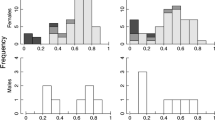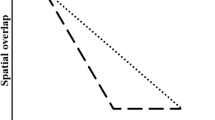Abstract
Space use and territoriality influence population structure and dynamics and is therefore an important aspect in understanding the ecology of animals. We investigated spatial and temporal space use of wolverines (Gulo gulo) in northern Scandinavia. We estimated home ranges of 24 radio-marked individuals (17 females and seven males). Male home ranges (mean 669 km2; SE = 211) were significantly larger than female home ranges (mean 170 km2; Wilcoxon–Mann–Whitney; P = 0.001) and encompassed or included parts of up to five different females. Home range sizes of reproducing (170 km2; SE = 51) and barren (171 km2; SE = 63) adult females did not differ. Wolverines in Scandinavia exhibit intrasexual territoriality, with male home ranges totally exclusive and female home ranges either exclusive or with little home range overlap. Overlap between wolverine territories is most likely explained by intrasexual tolerance and kinship.


Similar content being viewed by others
References
Ackerman BB, Leban FA, Samuel MD, Garton EO (1990) User’s manual for program HOME RANGE. Technical Report 15, Forestry, Wildlife and Range Experiment Station. University of Idaho, Moscow
Adams EA (2001) Approaches to the study of territory size and shape. Ann Rev Ecolog Syst 32:277–303
Arnemo JM, Fahlman Å (2007) Biomedical protocol for free-ranging brown bears, gray wolves, wolverines and lynx. Norwegian School of Veterinary Science, Tromsø, Norway. http://www4.nina.no/skandlo/pdf/Biomedical%20protocols%20carnivores%20210807.pdf. Accessed 12 Jan 2009
Banci V (1987) Ecology and behaviour of wolverine in Yukon. M.Sc. thesis, Simon Fraser University, Burnaby, Canada
Banci V (1994) Wolverine. In: Ruggiero LF, Aubry KB, Buskirk SW, Lyon LJ, Zielinski WJ (eds) The scientific basis for conserving forest carnivores. American marten, fisher, lynx and wolverine in the western United States. General Technical Report RM-254. U.S. Department of Agriculture, Forest Service, Rocky Mountain Forest and Range Experiment Station, Fort Collins, USA, pp 99–127
Bjärvall A (1982) A study of the wolverine female during the denning period. Transactions of the International Congress of Game Biologists 14:315–322
Brown JL, Orians GH (1970) Spacing patterns in mobile animals. Ann Rev Ecolog Syst 1:239–262
Burt WH (1943) Territoriality and home range concepts as applied to mammals. J Mammal 24:346–352
Cairns SJ, Schwager SJ (1987) A comparison of association indices. Anim Behav 35:454–1469
Copeland JP (1996) Biology of the wolverine in central Idaho. M.Sc. thesis, University of Idaho, Moscow, USA
Dahl F, Willebrand T (2005) Natal dispersal, adult home ranges and site fidelity of mountain hares Lepus timidus in the boreal forest of Sweden. Wildlife Biol 11:309–317
Erlinge S (1977) Spacing strategy in stout Mustela erminea. Oikos 28:32–42
Flagstad Ø, Hedmark E, Landa A, Brøseth H, Persson J, Andersen R, Segerström P, Ellegren H (2004) Colonization history and non-invasive monitoring of a re-established wolverine population. Conserv Biol 18:1–13
Gärdenfors U (2000) How are species redlisted? Manual and guidelines. Artdatabanken, SLU, Uppsala, Sweden
Genovesi P, Sinibaldi I, Boitani L (1997) Spacing patterns and territoriality of the stone marten. Can J Zool 75:1966–1971
Ginsberg JR, Young T (1992) Measuring association between individuals or groups in behavioural studies. Anim Behav 44:377–379
Grundsten C (1997) The Laponian area: a world heritage site. Swedish Environmental Protection Agency. Fälths Tryckeri AB, Stockholm, Sweden
Harestad AS, Bunnell FL (1979) Home range and body weight—a re-evaluation. Ecology 60:389–402
Harris S, Creswell WJ, Forde PG, Trewhella T, Woollard T, Wray S (1990) Home-range analysis using radio-tracking data—a review of the problems and techniques particularly as applied to the study of mammals. Mamm Rev 20:97–123
Hedmark E, Persson J, Segerström P, Landa A, Ellegren H (2007) Paternity and mating system in wolverines Gulo gulo. Wildlife Biol 13(Suppl 2):13–30
Hooge PN, Eichenlaub B (1997) Animal Movement Extension to arcview, Ver. 1.1. Alaska Biological Science Center, US Geological Survey, Anchorage, AK
Hornocker MG, Hash HS (1981) Ecology of the wolverine in northwestern Montana. Can J Zool 59:1286–1301
SAS Institute (2000) SAS/STAT user’s guide, version 6. SAS Institute, Cary, NC
Kenward R (2001) Wildlife radio tagging: equipment, field techniques and data analysis. Academic, London
Kernohan BJ, Gitzen RA, Millspaugh JJ (2001) Analysis of animal space use and movements. In: Millspaugh JJ, Marzluff JM (eds) Radio tracking and animal populations. Academic, San Diego, pp 125–166
Koehler GM, Hornocker MG, Hash HS (1980) Wolverine marking behaviour. Can Field-Nat 94:339–341
Krebs J, Lofroth E, Copeland J, Banci V, Cooley D, Golden H, Magoun A, Mulders R, Shults B (2004) Synthesis of survival rates and causes of mortality in North American wolverines. J Wildl Manage 68:493–502
Landa A, Strand O, Linell JDC, Skogland T (1998) Home-range sizes and altitude selection for arctic foxes and wolverines in an alpine environment. Can J Zool 76:448–457
Landa A, Linell JDC, Lindén M, Swenson JE, Røskaft E, Moksnes A (2000) Conservation of Scandinavian wolverines in ecological and political landscapes. In: Griffiths HI (ed) Mustelids in a modern world. Management and conservation aspects of small carnivore: human interactions. Backhuys Publishers, Leiden, pp 1–20
Lofroth EC (2001) Northern wolverine project: 2000/01 year end report. Forest renewal activity no. 712260, BC
Magoun AJ (1985) Population characteristics, ecology and management of wolverines in nortwestern Alaska. Ph.D. dissertation, University of Alaska, Fairbanks, USA
Maher CR, Lott DF (1995) Definitions of territoriality used in the study of variation in vertebrate spacing systems. Anim Behav 49:1581–1597
Minta SC (1992) Tests of spatial and temporal interaction among animals. Ecol Appl 2:178–188
Mohr CO (1947) Table of equivalent populations of North American small mammals. Am Midl Nat 37:223–249
Mustelid Specialist Group (1996) Gulo gulo. In: IUCN 2006. 2006 IUCN red list of threatened species. www.iucnredlist.org
Noble GK (1939) The role of dominance in the social life of birds. Auk 56:263–273
Persson J (2005) Female wolverine reproduction: reproductive costs and winter food availability. Can J Zool 83:1453–1459
Persson J (2007) Status and ecology of the wolverine in Sweden. Report to the Carnivore Commission 2007. www.sou.gov.se/storarovdjur/PDF/Artbeskrivning%20j%C3%A4rv%20v5.pdf
Persson J, Willebrand T, Landa A, Andersen R, Segerström P (2003) The role of intraspecific predation in the survival of juveniles wolverines Gulo gulo. Wildlife Biol 9:21–28
Persson J, Landa A, Andersen R, Segerström P (2006) Reproductive characteristics of female wolverines (Gulo gulo) in Scandinavia. J Mammal 87:75–79
Persson J, Ericsson G, Segerström P (2009) Human caused mortality in the endangered Scandinavian wolverine population. Biol Conserv 142:325–331
Powell RA (1979) Mustelid spacing patterns: variations on a theme by Mustela. Z Tierpsychol 50:153–165
Powell RA (2000) Animal home ranges and home range estimators. In: Boitani L, Fuller TK (eds) Research techniques in animal ecology controversies and consequences. Columbia University Press, New York, pp 65–110
Rausch RA, Pearson AM (1972) Notes on wolverine in Alaska and the Yukon territory. J Wildl Manage 36:249–268
Rodgers AR, Carr AP (1998) HRE: The Home Range Extension for ArcView. Ontario Ministry of Natural Resources, Centre for Northern Forest Ecosystem Research, Thunder Bay, ON
Sandell M (1989) The mating tactics and spacing patterns of solitary carnivores. In: Gittleman JL (ed) Carnivore, behaviour, ecology and evolution. Cornell University Press, New York, pp 164–182
Schoener TW (1968) Sizes of feeding territories among birds. Ecology 49:123–141
Schoener TW (1981) An empirically based estimate of home range. Theor Popul Biol 20:281–325
Seaman DE, Millspaugh JJ, Kernohan BJ, Brundige GC, Raedke KJ, Gitzen RA (1999) Effects of sample size on kernel home range estimates. J Wildl Manage 63:739–747
Siegel S, Castellan JN (1988) Nonparametric statistics for the behavioural sciences. McGraw-Hill Inc, USA
Slough B (2007) Status of the wolverine Gulo gulo in Canada. Wildlife Biol 13(Suppl 2):76–82
Swenson JE, Andrén H (2005) A tale of two countries: large carnivore depredations and compensation schemes in Sweden and Norway. In: Woodroffe R, Thirgood S, Rabinowitz A (eds) People and wildlife: conflict or co-existence?. Cambridge University Press, Cambridge, pp 323–339
Swihart RK, Slade NA (1985) Testing for independence of in animal movements. Ecology 66:1176–1184
Vangen MK, Persson J, Landa A, Andersen R, Segerström P (2001) Characteristics of dispersal in wolverines. Can J Zool 79:1641–1649
Wedholm P (2006) Territoriallity and social organization in Scandinavian wolverines Gulo gulo. M.Sc. thesis, Swedish University of Agricultural Sciences, Umeå, Sweden
White GC, Garrott RA (1990) Analysis of wildlife radio-tracking data. Academic, San Diego
Whitman JS, Ballard WB, Gardner CL (1986) Home range and habitat use by wolverines in south central Alaska. J Wildl Manage 50:460–463
Worton BJ (1989) Kernel methods for estimating the utilization distribution in home-range studies. Ecology 70:164–168
Zhang M, Liu Q, Piao R, Jiang G (2007) The wolverine Gulo gulo population in the Great Kinghan Mountains, northeastern China. Wildlife Biol 13(Suppl 2):83–88
Acknowledgements
This study was financially supported by the Swedish Environmental Protection Agency, Norwegian Directorate for Nature Management, World Wildlife Fund Sweden, and the Kempe Foundation. The study was approved by the Animal Ethics Committee for northern Sweden, Umeå. We thank an anonymous reviewer for comments on the manuscript.
Author information
Authors and Affiliations
Corresponding author
Additional information
Communicated by P. Krausman
Appendix
Appendix
Rights and permissions
About this article
Cite this article
Persson, J., Wedholm, P. & Segerström, P. Space use and territoriality of wolverines (Gulo gulo) in northern Scandinavia. Eur J Wildl Res 56, 49–57 (2010). https://doi.org/10.1007/s10344-009-0290-3
Received:
Revised:
Accepted:
Published:
Issue Date:
DOI: https://doi.org/10.1007/s10344-009-0290-3




